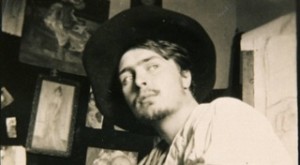
Rudolf Laban is known as a significant figure in 20th century modern dance. Yet he was 40 years old before he began to make a name for himself as a dancer. Prior to this time, Laban had been seriously engaged in the visual arts. And this first career as an artist decisively influenced his second career.
Laban studied art in Munich and Paris at the height of the popularity of the Art Nouveau movement. His surviving art works demonstrate his mastery of artist’s anatomy, proportion, and rendering in perspective – all staples of a traditional art training. Other works reveal his familiarity with stylistic features of the “new art.”
Art Nouveau promulgated fresh theories of art and original modes of representation. Artists looked at nature as a design source. But the biological and botanical forms they chose were not rendered realistically. Rather they were abstracted and turned into two-dimensional patterns. The resulting Art Nouveau designs played with symmetry and asymmetry, shifted figure and ground, and transformed biomorphic shapes into stylized curves and geometrical motifs.
As Laban struggled to find a way to record dance in symbols, he drew upon his knowledge of human anatomy and proportion and how to render the human figure in three-dimensional perspective. This helped him to understand the relationships between the dancer’s physical capabilities and the shapes and forms of the dance as it unfolded in the space around the dancer’s body.
When Laban turned his painter’s eye to dance, he also saw patterns. And in seeking to render these biomorphic patterns, he drew upon the theories and techniques of Art Nouveau. Through the creative combination of artistic traditions and innovations, Laban generated his unique theories of human movement. These were so unique he had to coin his own names – Choreutics, or space harmony, and Eukinetics, or effort theory. The following blogs discuss these theories in more detail.
